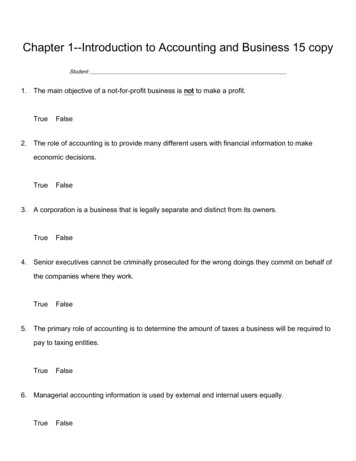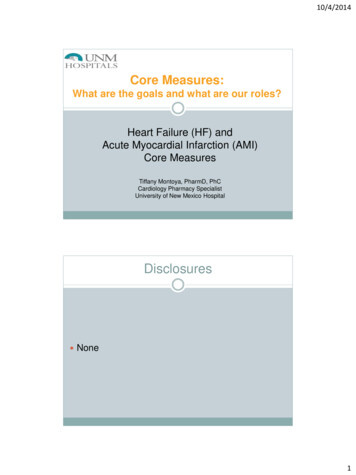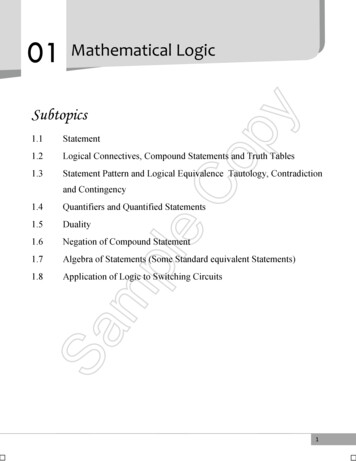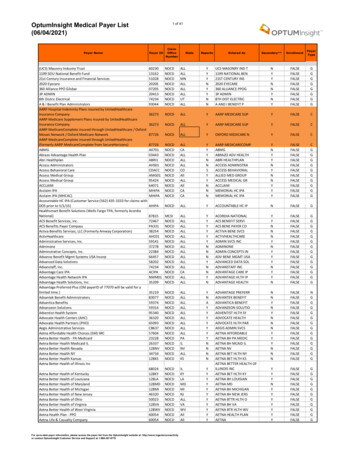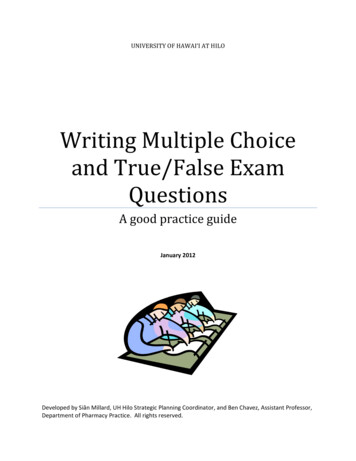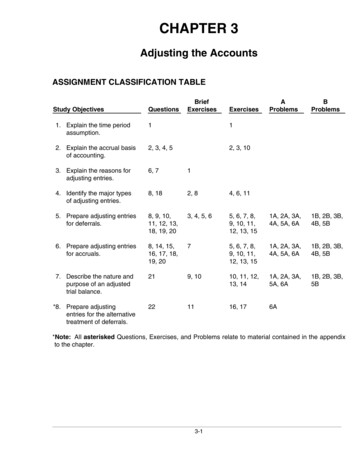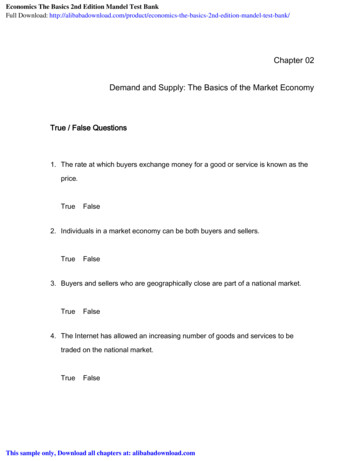
Transcription
Economics The Basics 2nd Edition Mandel Test BankFull Download: asics-2nd-edition-mandel-test-bank/Chapter 02Demand and Supply: The Basics of the Market EconomyTrue / False Questions1. The rate at which buyers exchange money for a good or service is known as theprice.TrueFalse2. Individuals in a market economy can be both buyers and sellers.TrueFalse3. Buyers and sellers who are geographically close are part of a national market.TrueFalse4. The Internet has allowed an increasing number of goods and services to betraded on the national market.TrueFalseThis sample only, Download all chapters at: alibabadownload.com
5. Crude oil is sold on a local market.TrueFalse6. The market price is the typical price at which a good or service sells.TrueFalse7. The individual quantity demanded is the amount the buyer is allowed to purchaseat a given price.TrueFalse8. The law of demand says that in most cases, the lower the price, the lower thequantity demanded.TrueFalse9. Zero-price products and services exist only in the technology sector.TrueFalse10. A demand schedule illustrates the quantities demanded for a particular product orservice at different prices.TrueFalse
Multiple Choice Questions11. The demand curve is the graphical counterpart to theA. demand schedule.B. supply curve.C. supply schedule.D. general demand.12. The law of demand suggests that most demand curves will beA. upward-sloping.B. a straight line.C. downward-sloping.D. variable.13. A supply schedule illustrates the quantity supplied atA. various demand levels.B. a single selling price.C. different selling prices.D. market equilibrium.
14. A market supply scheduleA. is all the products or services demanded in a market.B. combines the quantities supplied by all businesses in a market.C. has an upward-sloping demand curve.D. is determined by adding demand and supply.15. The law of supply says that higher prices tend to the quantity supplied of agood or service, assuming no other changes.A. increaseB. decreaseC. have no effect onD. first increase, then decrease16. Supply curves are generallyA. upward-sloping.B. downward-sloping.C. a straight line in real life.D. responsive to demand curves.
17. The demand schedule is a description of the behavior of in a market.A. sellersB. buyersC. a supply scheduleD. a demand schedule18. Ceteris paribus, when used by economists, meansA. for every action, there is a reaction.B. things never change.C. all other things equal.D. buyer beware.19. Opportunity cost is defined as the value or benefit of theA. most expensive item.B. least expensive item.C. supply curve.D. next best alternative.
20. If you wished to sell glasses of lemonade, but were uncertain at what price to selleach glass, you would use a , if one were available, to assist in thedecision.A. calculatorB. demand scheduleC. opportunity scheduleD. negotiated price21. The typical worker is a(n) in a labor market.A. buyerB. sellerC. opportunity costD. market demand22. Global markets consist of buyers and sellersA. anywhere in the world.B. only within their community.C. within a nation.D. within a state.
23. The market price can sometimes be difficult to identify due to which of thefollowing?A. The laws of supply and demand.B. Equilibriums.C. Satiation.D. Sale prices, negotiated prices, and volume discounts.24. Which of the following is NOT an example of an advance purchase discount?A. Prepaid tuition plans.B. Airline tickets.C. Movie tickets purchased online at a lower price than at the box office.D. Buying a soda at the local fast-food outlet.25. A market demand schedule for hamburgers would NOT include which of thefollowing?A. Vegetarians, who buy no hamburgers.B. People who eat a cheeseburger every day for lunch.C. The concept of ceteris paribus.D. The labor market.
26. If the market price of 10 per lawn leads to the quantity supplied of 15 mowedlawns, and the market price of 15 per lawn leads to 25 lawns mowed, which waydoes the supply curve slope?A. Downward.B. Upward.C. Horizontally.D. Vertically.27. Generally speaking, in the law of demand, the lower the price, the thequantity demanded.A. lowerB. greaterC. supply schedule showsD. market will adjust28. Which of the following is not an example of zero price?A. Most cable television plans.B. Unlimited cell-to-cell calling plans.C. Unlimited refills of coffee.D. A hot dog at a stand.
29. Which of the following is an example of a product that is sold primarily in a localmarket?A. Cheese.B. Butter.C. Milk.D. Oil.30. Sale prices mean that the price is lowered for a period of time.A. limitedB. longC. extendedD. prolonged31. Using the law of demand, what would generally happen if the price of gasolinewere to rise to 7.00 per gallon?A. The quantity demanded would increase.B. There would be no effect on demand.C. The quantity demanded would decrease.D. Automakers would increase production.
32. In economics, satiation meansA. eventually the marginal value of the good consumed increases.B. that you are full.C. eventually the marginal value of the good consumed decreases.D. that the market price has been attained.33. In contrast to the law of supply, sometimes can reduce the quantitysupplied.A. an increased priceB. a market supply curveC. a market demand curveD. price negotiations34. Markets can beA. global.B. national.C. local.D. global, national, and local.
35. What would it mean if a demand curve sloped upward?A. Quantity demanded drops as the price increases.B. Quantity demanded increases as the price increases.C. There is no relationship between price and quantity demanded.D. Quantity demanded increases as the price drops.36. A vertical supply curve would mean thatA. as price decreases, quantity supplied decreases.B. as price decreases, quantity supplied increases.C. the price does not affect the quantity supplied.D. market equilibrium has been reached.37. One of the biggest benefits of a market-based economy isA. centralized planning.B. the ability to adapt quickly to change.C. government regulation.D. consumer protection policies.
38. If the quantity demanded increases sharply when the price drops, this illustrateswhat principle?A. The law of supply.B. The law of demand.C. The law of the curve.D. Ceteris paribus.39. Which of the following is not an example of a good provided by a market?A. Online video games.B. Airline tickets between New York and Los Angeles.C. Pizza in Toledo, Ohio.D. The air we breathe.40. Buying a used textbook from a fellow student is an example of what type ofmarket?A. Local.B. National.C. Global.D. Labor.
41. The market price isA. the exact price a product sells for at a specific time.B. the typical price at which a good or service sells.C. always easy to determine.D. usually higher than the equilibrium price.42. What phrase do economists use to describe the assumption that everything elseabout a situation stays the same, while one variable, such as price, changes?A. E pluribus unum.B. Caveat emptor.C. Vini, vidi, vici.D. Ceteris paribus.43. When you give up the opportunity to do something else, the value to you of thatactivity is calledA. opportunity demand.B. opportunity cost.C. market price.D. equilibrium.
44. What might happen if the market price of haircuts went up?A. Haircutting would be less profitable.B. Some stylists would work fewer hours.C. Some salons might close.D. A hair salon might hire more stylists.45. The number of markets isA. Fixed.B. Always changing.C. Closed.D. Variable on a local basis, and fixed on a national basis.46. What is the price of labor in a market?A. The supply rate.B. The demand rate.C. The net profit.D. The wage rate.
47. The law of demandA. always holds true.B. is the opposite of the law of supply.C. works only in large markets.D. is a general tendency.48. The demand schedule reports the quantity demanded atA. different prices.B. one price.C. the average of all prices.D. the supply price.49. The supply schedule is a description ofA. the quantity demanded at a single price.B. the supply offered according to demand.C. the basis of calculating market price.D. the relationship between quantities supplied and market prices.
50. The individual quantity demanded is the amount the is willing to at agiven price.A. seller, purchaseB. buyer, purchaseC. buyer, sellD. seller, sell51. Natural resources, such as crude oil and fish, are often sold inmarkets.A. localB. nationalC. globalD. labor52. Households are generally buyers in the markets for products and sellers inmarkets.A. goodsB. serviceC. natural resourceD. labor
53.Refer to the table, which shows the number of MP3 downloads demanded permonth for the students at a certain university. Which of the following statementsdoes not explain why the quantity demanded was not higher for a price of 0?A. There are only so many songs that people want to listen to.B. Downloading an MP3 takes time.C. MP3s take up space on a computer's hard drive.D. People would rather pay for their downloads.
54.Refer to the table, which shows the number of MP3 downloads demanded permonth for the students at a certain university. Does this demand scheduleconform to the law of demand?A. Yes, because as the price falls, the quantity demanded rises.B. Yes, because as the price falls, the quantity demanded also falls.C. No, because there appears to be no relationship between price and quantitydemanded.D. No, because the demand for most goods does not follow the law of demand.
55.Refer to the table, which shows the number of MP3 downloads demanded permonth for the students at a certain university. What would happen to the quantityof MP3s demanded at a price of 2 if the university's enrollment were to increasesignificantly?A. The quantity demanded would fall below 200 because there would be morestudents competing for MP3s.B. The quantity demanded would remain at 200 because the number of buyers ina market does not impact the market demand schedule.C. The quantity demanded would increase above 200 because the marketdemand schedule is the sum of individual demand schedules, and morestudents mean more individual demand schedules for MP3s.D. The quantity demanded would rise to exactly 400 because every number in thetable would simply shift down one row.
56. Does the law of supply apply to labor markets?A. Yes, because all workers will increase the number of hours they work if theirwages increase.B. Yes, because some workers who are less committed to the labor force, liketeenagers, will decide to work if wages increase.C. No, because the laws of supply and demand both apply only to productmarkets.D. No, because workers have no control over the number of hours they work.57. The average sale price of a home in the United States increased from 207,000to 297,000 from 2000 to 2005. All else equal, we would expect that during thesame timeA. The quantity of new homes supplied also increased.B. The quantity of new homes supplied decreased.C. The quantity of new homes supplied did not change.D. The quantity of new homes supplied changed in proportion to changes in thepopulation.
58. If the average market price for haircuts increases, all else equal, which of thefollowing is LEAST likely to occur as a result?A. More new salons will open.B. Existing salons and barber shops will hire more stylists and barbers.C. Some workers will leave other jobs in order to become hair stylists.D. Many salons will go out of business.59. The market for automobiles in China has experienced tremendous growthprimarily because ofA. relaxed emissions standards in China.B. rising incomes in China.C. higher wages of American workers.D. the invention of new products.60. The market for iPads did not exist 30 years ago becauseA. consumers did not need or want iPads.B. portable electronic devices were illegal.C. the technology did not exist to produce iPads.D. iPads were too expensive for most consumers.
Short Answer Questions61. Explain why a demand curve slopes downward.62. What determines a market supply schedule?
63. What does an upward-sloping supply curve mean?64. Give three examples of why new markets are created every day.65. What do economists mean when they say ceteris paribus?
Chapter 02 Demand and Supply: The Basics of the Market EconomyAnswer KeyTrue / False Questions1.The rate at which buyers exchange money for a good or service is known asthe price.TRUEThe rate at which the buyer and seller exchange money for a good or service iscalled the price.AACSB: AnalyticBlooms: UnderstandDifficulty: 1 EasyLearning Objective: 02-01 Describe the key elements of a market.
2.Individuals in a market economy can be both buyers and sellers.TRUEA typical worker is a seller of labor, while also a buyer of products and services.AACSB: Reflective ThinkingBlooms: UnderstandDifficulty: 1 EasyLearning Objective: 02-01 Describe the key elements of a market.3.Buyers and sellers who are geographically close are part of a national market.FALSEBuyers and sellers who are geographically close are part of a local market.AACSB: AnalyticBlooms: RememberDifficulty: 2 MediumLearning Objective: 02-01 Describe the key elements of a market.
4.The Internet has allowed an increasing number of goods and services to betraded on the national market.TRUEMany services and products are available from the sellers' websites, regardlessof geography.AACSB: Reflective ThinkingBlooms: UnderstandDifficulty: 2 MediumLearning Objective: 02-01 Describe the key elements of a market.5.Crude oil is sold on a local market.FALSEBecause of the multinational basis of many oil companies, crude oil has beensold on a global market for decades.AACSB: AnalyticBlooms: RememberDifficulty: 2 MediumLearning Objective: 02-01 Describe the key elements of a market.
6.The market price is the typical price at which a good or service sells.TRUEThe market price is the typical price at which a good or service sells.AACSB: Reflective ThinkingBlooms: UnderstandDifficulty: 1 EasyLearning Objective: 02-01 Describe the key elements of a market.7.The individual quantity demanded is the amount the buyer is allowed topurchase at a given price.FALSEIndividual quantity demanded is based on the amount the buyer is willing topurchase at a given price.AACSB: Reflective ThinkingBlooms: UnderstandDifficulty: 2 MediumLearning Objective: 02-02 Explain how the price in a market affects the quantity demanded.
8.The law of demand says that in most cases, the lower the price, the lower thequantity demanded.FALSEThe law of demand says a lower price tends to increase the quantitydemanded, all other things equal.AACSB: AnalyticBlooms: RememberDifficulty: 2 MediumLearning Objective: 02-02 Explain how the price in a market affects the quantity demanded.9.Zero-price products and services exist only in the technology sector.FALSEYou can use all-you-can-eat buffets, as well as unlimited refills of coffee, asexamples of zero-price products outside of technology.AACSB: Reflective ThinkingBlooms: UnderstandDifficulty: 2 MediumLearning Objective: 02-02 Explain how the price in a market affects the quantity demanded.
10.A demand schedule illustrates the quantities demanded for a particular productor service at different prices.TRUEThe demand schedule illustrates the link between a buyer's quantity demandedand price.AACSB: Reflective ThinkingBlooms: RememberDifficulty: 2 MediumLearning Objective: 02-02 Explain how the price in a market affects the quantity demanded.Multiple Choice Questions
11.The demand curve is the graphical counterpart to theA. demand schedule.B. supply curve.C. supply schedule.D. general demand.The demand curve shows the graphical representation of quantity demanded atdifferent prices.AACSB: Reflective ThinkingBlooms: UnderstandDifficulty: 2 MediumLearning Objective: 02-02 Explain how the price in a market affects the quantity demanded.12.The law of demand suggests that most demand curves will beA. upward-sloping.B. a straight line.C. downward-sloping.D. variable.As price increases, there is usually a reduction in quantity demanded, causingthe downward slope on a demand curve.AACSB: Reflective ThinkingBlooms: Understand
Difficulty: 2 MediumLearning Objective: 02-02 Explain how the price in a market affects the quantity demanded.13.A supply schedule illustrates the quantity supplied atA. various demand levels.B. a single selling price.C. different selling prices.D. market equilibrium.The supply schedule for a good or service reports the quantity supplied atdifferent selling prices.AACSB: Reflective ThinkingBlooms: UnderstandDifficulty: 3 HardLearning Objective: 02-03 Explain how the price in a market affects the quantity supplied.
14.A market supply scheduleA. is all the products or services demanded in a market.B. combines the quantities supplied by all businesses in a market.C. has an upward-sloping demand curve.D. is determined by adding demand and supply.The market supply schedule adds up the quantity supplied by all the sellers in amarket.AACSB: Reflective ThinkingBlooms: UnderstandDifficulty: 2 MediumLearning Objective: 02-03 Explain how the price in a market affects the quantity supplied.15.The law of supply says that higher prices tend to the quantity supplied ofa good or service, assuming no other changes.A. increaseB. decreaseC. have no effect onD. first increase, then decreaseThe law of supply states that a higher price tends to increase the quantitysupplied, all other things equal.AACSB: Reflective Thinking
Blooms: UnderstandDifficulty: 3 HardLearning Objective: 02-03 Explain how the price in a market affects the quantity supplied.16.Supply curves are generallyA. upward-sloping.B. downward-sloping.C. a straight line in real life.D. responsive to demand curves.As the price of a product or service increases, generally so does the quantitysupplied, creating an upward-sloping supply curve.AACSB: Reflective ThinkingBlooms: UnderstandDifficulty: 3 HardLearning Objective: 02-03 Explain how the price in a market affects the quantity supplied.
17.The demand schedule is a description of the behavior of in a market.A. sellersB. buyersC. a supply scheduleD. a demand scheduleThe demand schedule provides a link between a buyer's quantity demandedand the price.AACSB: Reflective ThinkingBlooms: UnderstandDifficulty: 1 EasyLearning Objective: 02-02 Explain how the price in a market affects the quantity demanded.18.Ceteris paribus, when used by economists, meansA. for every action, there is a reaction.B. things never change.C. all other things equal.D. buyer beware.In assuming a demand schedule, economists use the concept of ceterisparibus to mean that the schedule reflects no other changes aside from priceand demand.AACSB: Reflective Thinking
Blooms: UnderstandDifficulty: 3 HardLearning Objective: 02-01 Describe the key elements of a market.19.Opportunity cost is defined as the value or benefit of theA. most expensive item.B. least expensive item.C. supply curve.D. next best alternative.See the definition of opportunity cost.AACSB: AnalyticBlooms: RememberDifficulty: 2 MediumLearning Objective: 02-02 Explain how the price in a market affects the quantity demanded.
20.If you wished to sell glasses of lemonade, but were uncertain at what price tosell each glass, you would use a , if one were available, to assist inthe decision.A. calculatorB. demand scheduleC. opportunity scheduleD. negotiated priceThe demand schedule shows a seller the optimal (highest demanded) price fora product or service.AACSB: Reflective ThinkingBlooms: UnderstandDifficulty: 2 MediumLearning Objective: 02-02 Explain how the price in a market affects the quantity demanded.21.The typical worker is a(n) in a labor market.A. buyerB. sellerC. opportunity costD. market demandWorkers typically sell their time for money.AACSB: Analytic
Blooms: RememberDifficulty: 1 EasyLearning Objective: 02-01 Describe the key elements of a market.22.Global markets consist of buyers and sellersA. anywhere in the world.B. only within their community.C. within a nation.D. within a state.Global markets allow buyers and sellers to be anywhere in the world.AACSB: AnalyticBlooms: RememberDifficulty: 1 EasyLearning Objective: 02-01 Describe the key elements of a market.
23.The market price can sometimes be difficult to identify due to which of thefollowing?A. The laws of supply and demand.B. Equilibriums.C. Satiation.D. Sale prices, negotiated prices, and volume discounts.Sale prices, negotiated prices, and volume discounts each affect market price.AACSB: Reflective ThinkingBlooms: UnderstandDifficulty: 3 HardLearning Objective: 02-01 Describe the key elements of a market.24.Which of the following is NOT an example of an advance purchase discount?A. Prepaid tuition plans.B. Airline tickets.C. Movie tickets purchased online at a lower price than at the box office.D. Buying a soda at the local fast-food outlet.When the buyer pays for a good or service in advance, the buyer typically willreceive a discount from the market price.AACSB: Reflective ThinkingBlooms: Understand
Difficulty: 2 MediumLearning Objective: 02-01 Describe the key elements of a market.25.A market demand schedule for hamburgers would NOT include which of thefollowing?A. Vegetarians, who buy no hamburgers.B. People who eat a cheeseburger every day for lunch.C. The concept of ceteris paribus.D. The labor market.The market demand schedule for hamburgers would tell us how manyhamburgers would be bought by people at any given price.AACSB: Reflective ThinkingBlooms: UnderstandDifficulty: 3 HardLearning Objective: 02-02 Explain how the price in a market affects the quantity demanded.
26.If the market price of 10 per lawn leads to the quantity supplied of 15 mowedlawns, and the market price of 15 per lawn leads to 25 lawns mowed, whichway does the supply curve slope?A. Downward.B. Upward.C. Horizontally.D. Vertically.When market price increases, and you have a corresponding increase inquantity supplied, there is an upward slope.AACSB: Reflective ThinkingBlooms: UnderstandDifficulty: 1 EasyLearning Objective: 02-03 Explain how the price in a market affects the quantity supplied.
27.Generally speaking, in the law of demand, the lower the price, the thequantity demanded.A. lowerB. greaterC. supply schedule showsD. market will adjustThe law of demand states that a lower price tends to increase the quantitydemanded, all other things equal.AACSB: Reflective ThinkingBlooms: UnderstandDifficulty: 2 MediumLearning Objective: 02-02 Explain how the price in a market affects the quantity demanded.
28.Which of the following is not an example of zero price?A. Most cable television plans.B. Unlimited cell-to-cell calling plans.C. Unlimited refills of coffee.D. A hot dog at a stand.Some products come with a zero price, so that you get an additional unit of agood or service at no extra charge. For example, we may pay an initial fee buthave unlimited use.AACSB: AnalyticBlooms: RememberDifficulty: 1 EasyLearning Objective: 02-01 Describe the key elements of a market.
29.Which of the following is an example of a product that is sold primarily in a localmarket?A. Cheese.B. Butter.C. Milk.D. Oil.Due to transportation issues and government regulations, milk is primarily soldlocally. Cheese and butter are sold globally.AACSB: Reflective ThinkingBlooms: UnderstandDifficulty: 1 EasyLearning Objective: 02-01 Describe the key elements of a market.30.Sale prices mean that the price is lowered for a period of time.A. limitedB. longC. extendedD. prolongedA sale price is intentionally set below the market price for a limited time tostimulate purchases.AACSB: Analytic
Blooms: RememberDifficulty: 1 EasyLearning Objective: 02-01 Describe the key elements of a market.31.Using the law of demand, what would generally happen if the price of gasolinewere to rise to 7.00 per gallon?A. The quantity demanded would increase.B. There would be no effect on demand.C. The quantity demanded would decrease.D. Automakers would increase production.According to the law of demand, when the price increases, there generally is acorresponding decrease in quantity demanded.AACSB: Reflective ThinkingBlooms: UnderstandDifficulty: 2 MediumLearning Objective: 02-02 Explain how the price in a market affects the quantity demanded.
32.In economics, satiation meansA. eventually the marginal value of the good consumed increases.B. that you are full.C. eventually the marginal value of the good consumed decreases.D. that the market price has been attained.You reach a satiation point when the good consumed no longer has value.There is only so much free coffee you can drink before your body physicallyrebels.AACSB: AnalyticBlooms: RememberDifficulty: 2 MediumLearning Objective: 02-02 Explain how the price in a market affects the quantity demanded.
33.In contrast to the law of supply, sometimes can reduce the quantitysupplied.A. an increased priceB. a market supply curveC. a market demand curveD. price negotiationsLabor markets provide a good example: If you have a goal to earn 2,000, andare paid 10 per hour, it will take you 200 hours to achieve that goal. If yourrate increases to 20 per hour, the amount of labor you supply to reach yourgoal will decrease.AACSB: Reflective ThinkingBlooms: UnderstandDifficulty: 2 MediumLearning Objective: 02-03 Explain how the price in a market affects the quantity supplied.
34.Markets can beA. global.B. national.C. local.D. global, national, and local.Markets are a way for buyers and sellers to voluntarily exchange goods andservices for money.AACSB: AnalyticBlooms: RememberDifficulty: 1 EasyLearning Objective: 02-01 Describe the key elements of a market.35.What would it mean if a demand curve sloped upward?A. Quantity demanded drops as the price increases.B. Quantity demanded increases as the price increases.C. There is no relationship between price and quantity demanded.D. Quantity demanded increases as the price drops.Demand curves are generally downward-sloping because as price falls,quantity demanded rises.AACSB: AnalyticBlooms: Understand
Difficulty: 3 HardLearning Objective: 02-02 Explain how the price in a market affects the quantity demanded.36.A vertical supply curve would mean thatA. as price decreases, quantity supplied decreases.B. as price decreases, quantity supplied increases.C. the price does not affect the quantity supplied.D. market equilibrium has been reached.A vertical supply curve would imply that quantity supplied was constant,regardless of the price.AACSB: AnalyticBlooms: UnderstandDifficulty: 3 HardLearning Objective: 02-03 Explain how the price in a market affects the quantity supplied.
37.One of the biggest benefits of a market-based economy isA. centralized planning.B. the ability to adapt quickly to change.C. government regulation.D. consumer protection policies.New markets are created everyday to the changing needs of consumers and totake advantage of the changing capabilities of producers.AACSB: Reflective ThinkingBlooms: UnderstandDifficulty: 2 MediumLearning Objective: 02-04 Discuss why the number of markets can increase.38.If the quantity demanded increases sharply when the price drops, thisillustrates what principle?A. The law of supply.B. The law of demand.C. The law of the curve.D. Ceteris paribus.The law of demand states that when a price drops, the quantity demandedgenerally increases.AACSB: Analytic
Blooms: RememberDifficulty: 1 EasyLearning Objective: 02-02 Explain how the price in a market affects the quantity demanded.39.Which of the following is not an example of a good provided by a market?A. Online video games.B. Airline tickets between New York and Los Angeles.C. Pizza in Toledo, Ohio.D. The air we breathe.The air we breathe is not exchanged between buyers and sellers.AACSB: Reflective ThinkingBlooms: UnderstandDifficulty: 1 EasyLearning Objective: 02-01 Describe the key elements of a market.
40.Buying a used textbook from a fellow student is an example of what type ofmarket?A. Local.B. National.C. Global.D. Labor.Because the textbook sale was person to person, within a specific school, thisis an example of a local market.AACSB: Reflective ThinkingBlooms: UnderstandDifficulty: 1 EasyLearning Objective: 02-01 Describe the key elements of a market.41.The market price isA. the exact price a product sells for at a specific time.B. the typical price at which a good or service sells.C. always easy to determine.D. usually higher than the equilibrium price.Market price is the typical price at which a good or service sells.AACSB: AnalyticBlooms: Remember
Difficulty: 1 EasyLearning Objective: 02-01 Describe the key elements of a market.42.What phrase do economists use to describe the assumption that everythingelse about a situation stays the same, while one variable, such as price,changes?A. E pluribus unum.B. Caveat emptor.C. Vini, vidi, vici.D. Ceteris paribus.The implicit assumption that everything else about a buying situation stays thesame when the price changes is called ceteris paribus, meaning all other thingsequal.AACSB: AnalyticBlooms: RememberDifficulty: 1 EasyLearning Objective: 02-01 Describe the key elements of a market.
43.When you give up the opportunity to do something else, the value to you of thatactivity is calledA. opportunity demand.B. opportunity cost.C. market price.D. equilibrium.Opportunity cost is the value or benefit of the next-best alternative use ofmoney or time.AACSB: Reflective ThinkingBlooms: UnderstandDifficulty: 1 EasyLearning Objective: 02-02 Explain how the price in a market affects the quantity demanded.44.What might happen if the market price of haircuts went up?A. Haircutting would be less profitable.B. Some styli
Demand and Supply: The Basics of the Market Economy True / False Questions 1. The rate at which buyers exchange money for a good or service is known as the price. True False 2. Individuals in a market economy can be both buyers and sellers. True False 3. Buyers and sellers who are geograph

